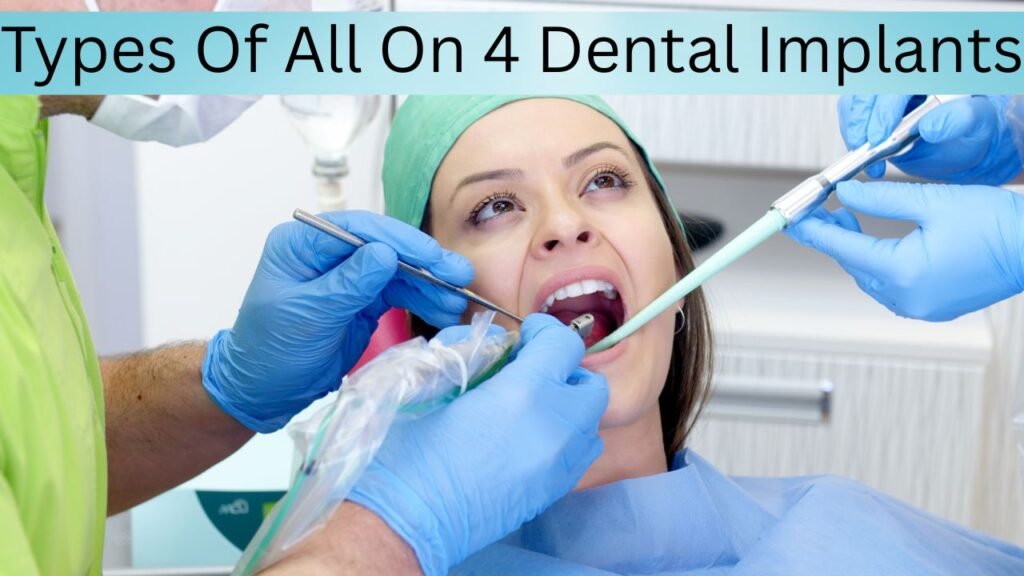Missing most or all of your teeth? Struggling with dentures that slip and feel awkward? If yes, you’re probably searching for a solution that’s permanent, stable, and looks like the real thing. That’s where All-On-4 dental implants come in.
Now, imagine four strong anchors placed into your jaw—like the firm legs of a sturdy table. These implants are tilted and placed with precision to hold an entire arch of teeth. Two implants go straight in the front, and two in the back are angled—typically at 30° to 45°. This unique design avoids the sinus or nerve canals and gives you great stability without needing bone grafts.
And here’s the cool part—it often lets you walk out with teeth the same day. For many in the U.S. dealing with failing teeth or full dentures, this technique feels like getting their life back.

Types of All-On-4 Dental Implants (Explained Like You’re Sitting in the Chair)
Let’s break down the four main types of All-On-4 implants so you can figure out which one fits your needs best.
1. Traditional All-On-4 Dental Implants
This is the original and most commonly recommended version. Dentists use four full-sized titanium implants to support a full-arch prosthesis.
🦷 What’s the process like?
- After implant surgery, a temporary acrylic bridge is attached.
- Over the next 3–6 months, osseointegration occurs. This means your jawbone grows around the implants, locking them in place.
- Once healed, the final prosthetic—usually zirconia or porcelain—is fitted.
🔧 Maintenance:
- Daily cleaning under the bridge with a water flosser.
- Regular checkups every 6 months.
- Professional cleaning at least once a year.
❓ What to Ask Your Dentist:
- Will I need bone grafting before implants?
- What material will be used for my final bridge?
- How long is the healing phase?
2. Hybrid All-On-4 Implants (Titanium-Zirconia Blend)
Think of this as the aesthetic powerhouse. A hybrid combines a titanium frame for strength and a zirconia or porcelain overlay for natural looks.
🌟 Why people love it:
- Zirconia mimics natural enamel with light-reflective translucency.
- Porcelain allows for exact shade matching to neighboring teeth.
- Titanium base adds serious strength without adding weight.
⚠️ Maintenance Tips:
- Avoid biting down on very hard foods.
- Use non-abrasive toothpaste to avoid scratching the surface.
❓ What to Ask Your Dentist:
- Which is better for me—porcelain or zirconia?
- Is the frame milled in-house or sent to a lab?
- What happens if a tooth chips?
3. Mini All-On-4 Implants
Mini implants are smaller in diameter and less invasive to place. They’re sometimes used when jawbone density is low or for temporary support.
👨⚕️ Best for:
- Elderly patients or those with compromised bone.
- Stabilizing overdentures while waiting for full treatment.
⚖️ Limitations:
- Not designed to handle heavy bite force.
- May not last as long as traditional implants.
- Often seen as a transitional solution, not a forever fix.
❓ What to Ask Your Dentist:
- Am I a candidate for full-sized implants?
- Will mini implants eventually need to be replaced?
- How long can I use them safely?
4. Immediate Load All-On-4 Implants (Teeth in a Day)
This is where modern implantology shines. You walk in needing teeth—walk out with them.
🕓 Key Criteria:
- Your bone must provide primary stability for implants.
- Typically, your temporary teeth are made from PMMA (polymethyl methacrylate).
🤐 Precautions Post-Surgery:
- Stick to soft foods for the first 8–12 weeks.
- Follow every cleaning instruction—this phase is crucial for osseointegration.
❓ What to Ask Your Dentist:
- What’s the risk of implant failure with immediate loading?
- Will I need a second surgery to attach the final bridge?
- Can I go back to normal eating after surgery?
Quick Comparison Table – Which One Fits You Best?
| Implant Type | Material Used | Healing Time | Best For | Key Benefit | Estimated Cost Range |
|---|---|---|---|---|---|
| Traditional | Titanium + Acrylic/Zirconia | 3–6 months | Most patients | Stability + Proven success | $20,000–$28,000 |
| Hybrid | Titanium frame + Zirconia | 3–6 months | Aesthetics-focused patients | Strength + Realistic appearance | $25,000–$32,000 |
| Mini | Narrow-diameter titanium | 1–2 months | Temporary use or low bone density | Less invasive + Lower cost | $10,000–$15,000 |
| Immediate Load | Titanium + PMMA temp | Same day fit | Patients with good bone quality | Fast results | $20,000–$30,000 |
Real Talk: Which Type Should You Choose?
Your choice depends on a few things:
- How much bone you have
- Your health and age
- How fast you want results
- What your budget looks like
- How long you want it to last
There’s no one-size-fits-all. That’s why your initial consultation with a skilled implant dentist is crucial. They’ll use 3D scans, check bone levels, and help you decide based on your goals.
Before You Commit – Ask These Questions at Your Consultation
Here’s a quick checklist to bring with you:
- What type of All-On-4 implant is best for my jawbone?
- How long will the healing process take in my case?
- What are the risks of immediate load implants?
- Can you show me before-and-after results of similar patients?
- What’s the warranty on the final prosthesis?
- Will you use in-house lab or outsource?
conclusion:
Choosing the right type of All-On-4 dental implant isn’t just a clinical decision—it’s personal. Whether you need strength, speed, beauty, or budget-conscious solutions, there’s an option tailored for you.
With this guide, you’re now one step closer to regaining your bite, your smile, and honestly—your confidence.
So ask the right questions, do your homework, and trust a U.S.-based dental team with experience in advanced implant techniques.
You don’t just deserve a smile that looks great—you deserve one that lasts.
Find Your Perfect Dentist
Book appointments with top-rated dentists in your area